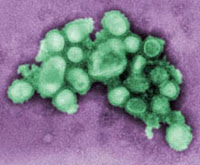New drug may be better against H1N1, bird flu
 An experimental new drug could be more effective than existing drugs against swine flu and bird flu, a UW-Madison researcher found.
An experimental new drug could be more effective than existing drugs against swine flu and bird flu, a UW-Madison researcher found.The drug, T-705, or favipiravir, was previously found to be effective against swine flu, or H1N1। Now Yoshihiro Kawaoka, a virologist at the university, has shown that the drug protects mice against bird flu, or H5N1।
Kawaoka and other flu experts consider bird flu to be a more dangerous global threat than swine flu because it is more deadly, even though it hasn't become as widespread in people.
T-705, developed by the Japanese company Toyama, could offer an alternative to Tamiflu, the main drug against all kinds of flu, Kawaoka said. Some flu viruses have become resistant to Tamiflu, so other drugs are needed, he said.
"We need a drug that targets different molecules of the influenza virus," Kawaoka said.
T-705, which attacks a different flu molecule than Tamiflu does, is being tested in people in Japan.
Kawaoka compared T-705 and Tamiflu in mice infected with bird flu. T-705 worked as well or better than Tamiflu, he found in a study published Monday in the Proceedings of the National Academy of Sciences.
When both drugs were given three days after infection, T-705 worked twice as well at Tamiflu, the study found. That is significant because many flu patients aren't able to get medical care soon enough for Tamiflu to be helpful, Kawaoka said.
While swine flu has been getting significant attention in recent months and is more of an immediate concern, bird flu remains more of a threat because its potential to kill appears to be greater, Kawaoka said.
Relatively few cases of bird flu have been reported this year in people, but a man died from it last month in Vietnam, according to the World Health Organzation.
Meanwhile, vaccine against swine flu is widely available in Wisconsin after a shortage this fall. The Madison-Dane County Health Department plans to resume school-based clinics next month, spokesman Jeff Golden said.
read more» Read more...














